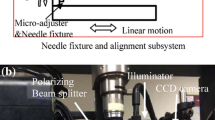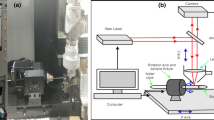Abstract
Micro-features are frequently created on medical needles to improve the visibility and friction behavior in ultrasound-guided percutaneous procedures. Ultra-short pulsed laser ablation is the front runner among the current material micro-processing technologies. In this paper, the effect of process parameters in laser surface texturing (LST) of medical needles was studied by experiments based on Taguchi methodology. The evolution of ablation dimension and surface roughness with different process parameters was measured by optical microscope. Based on response surface regression, mathematical models for correlating the machined depth and surface roughness with the overlap and overscan number were developed. Analysis of variance (ANOVA) was carried out to access the adequacy of the developed mathematical models. The results indicate that the developed mathematical models can predict the machined depth and surface roughness during LST operation satisfactorily. Analyses were made to study the effect of the process parameters on the machined micro-channel. From the analysis, it was found that the overlap and overscan number have great influences on the machined depth and surface roughness.













Similar content being viewed by others
References
P. Han, D. Che, K. Pallav, K.F. Ehmann, Models of the cutting edge geometry of medical needles with applications to needle design. Int. J. Mech. Sci. 65, 157–167 (2012)
N. Abolhassani, R. Patel, M. Moallem, Needle insertion into soft tissue: a survey. Med. Eng. Phys. 29(4), 413–431 (2007)
K.A. Chin, A. Perlas, V.W.S. Chan, R. Brull, Needle visualization in ultrasound-guided regional anesthesia: challenges and solutions. Reg. Anesth. Pain Med. 33(6), 532–544 (2008)
W.C. Culp, T.C. McCowan, T.C. Goertzen, T.G. Habbe, M.M. Hummel, R.F. Leveen, J.C. Anderson, Relative ultrasonographic echogenicity of standard, dimpled, and polymeric-coated needles. J. Vasc. Interv. Radiol. 11(3), 351–358 (2000)
R.K. Deam, R. Kluger, M.J. Barrington, C.A. McCutcheon, Investigation of a new echogenic needle for use with ultrasound peripheral nerve blocks. Anesth. Intensive Care 35(4), 582–586 (2007)
G. Hocking, S. Hebard, Echogenic technology can improve needle visibility during ultrasound-guided regional anesthesia. Reg. Anesth. Pain Med. 36(2), 185–189 (2011)
P. Han, J. Kim, K.F. Ehmann, J. Cao, Laser surface texturing of medical needles for friction control. Int. J. Mechatron. Manuf. Syst. 6(3), 215–228 (2013)
K. Oka, S. Aoyagi, Y. Arai, Y. Isono, G. Hashiguchi, H. Fujita, Fabrication of a micro needle for a trace blood test. Sens. Actuators A Phys. 97–98, 485–487 (2002)
H. Izumi, S. Aoyagi, Novel fabrication method for long silicon microneedles with three-dimensional sharp tips and complicated shank shapes by isotropic dry etching. IEEJ Trans. Electr. Electron. Eng. 2(3), 328–334 (2007)
S. Aoyagi, I. Izumi, T. Aoki, M. Fukuda, Development of a micro lancet needle made of biodegradable polymer for low-invasive medical treatment. Transducers ‘05 Dig. Tech. Pap. 1–2, 1195–1198 (2005)
H. Izumi, M. Suzuki, S. Aoyagi, T. Kanzaki, Realistic imitation of mosquito’s proboscis: electrochemically etched sharp and jagged needles and their cooperative inserting motion. Sens. Actuators A Phys. 165(1), 115–123 (2011)
H. Yun, H. Kim, Development of DMD-based micro-stereolithography apparatus for biodegradable multi-material micro-needle fabrication. J. Mech. Sci. Technol. 27(10), 2973–2978 (2013)
L. Frasson, T. Parittotokkaporn, A. Schneider, B.L. Davies, J.F.V. Vincent, S.E. Huq, P. Degenaar, F.M. Rodriguez Baena, Biologically inspired microtexturing: investigation into the surface topography of next-generation neurosurgical probes, in 30th Annual International IEEE EMBS Conference, Vancouver, British Columbia, Canada, 2008
X. Qi, Y.C. Qi, Y. Li, Q. Cong, The insect fascicle morphology research and bionic needle pierced mechanical mechanism analysis. Adv. Nat. Sci. 3(2), 251–257 (2010)
J. Chae, S.S. Park, T. Freiheit, Investigation of micro-cutting operations. Int. J. Mach. Tool Manuf. 46(3–4), 313–332 (2006)
K. Liu, B. Lauwers, D. Reynaerts, Process capabilities of micro-EDM and its applications. Int. J. Adv. Manuf. Tech. 47(1–4), 11–19 (2010)
K.P. Rajurkar, M.M. Sundaram, A.P. Malshe, Review of electrochemical and electro discharge machining. Proc. CIRP 6, 13–16 (2013)
R. Mathew, M.M. Sundaram, Modeling and fabrication of micro tools by pulsed electrochemical machining. J. Mater. Process. Technol. 212(7), 1567–1572 (2012)
X. Hu, Z. Yu, KP. Rajurkar, State-of-the-art review of micro ultrasonic machining, in MSEC 2006: Proceedings of the ASME 2006 International Manufacturing Science and Engineering Conference, Ypsilanti, Michigan, USA, 2006
D.M. Allen, P. Shore, R.W. Evans, C. Fanara, W. O’Brien, S. Marson, W. O’Neil, Ion beam, focused ion beam, and plasma discharge machining. CIRP Ann. Manuf. Technol. 58(2), 647–662 (2009)
M.Y. Ali, W. Huang, Y. Fu, A review of focused ion beam sputtering. Int. J. Precis. Eng. Manuf. 11(1), 157–170 (2010)
A.K. Dubey, V. Yadava, Laser beam machining—a review. Int. J. Mach. Tool Manuf. 48(6), 609–628 (2008)
J. Cheng, C.S. Liu, S. Shang, D. Liu, W. Perrie, G. Dearden, K. Watkins, A review of ultrafast laser materials micromachining. Opt. Laser Technol. 46, 88–102 (2013)
P. Bartolo, J. Kruth, J. Silva, G. Levy, A. Malshe, K. Rajurkar, M. Mitsuishi, J. Ciurana, M. Leu, Biomedical production of implants by additive electro-chemical and physical processes. CIRP Ann. Manuf. Technol. 61, 635–655 (2012)
P. Guo, K.F. Ehmann, Development of a tertiary motion generator for elliptical vibration texturing. Precis. Eng. 37(2), 364–371 (2013)
R. Singh, S.N. Melkote, Characterization of a hybrid laser-assisted mechanical micromachining (LAMM) process for a difficult-to-machine material. Int. J. Mach. Tool Manuf. 47(7–8), 1139–1150 (2007)
Q.H. Zhang, R. Du, J.H. Zhang, Q.B. Zhang, An investigation of ultrasonic-assisted electrical discharge machining in gas. Int. J. Mach. Tool Manuf. 46(12–13), 1582–1588 (2006)
A.K. Dubey, V. Yadava, Multi-objective optimisation of laser beam cutting process. Opt. Laser Technol. 40, 562–570 (2008)
J. Cheng, W. Perrie, M. Sharp, S.P. Edwardson, N.G. Semaltianos, G. Dearden, K.G. Watkins, Single-pulse drilling study on Au, Al and Ti alloy by using a picosecond laser. Appl. Phys. A Mater. 95(3), 739–746 (2009)
Acknowledgments
The support of the National Science Foundation (Grant #CMMI-0825722) and of the Korea Institute of Machinery and Materials is gratefully appreciated. X. Wang and Y. Xing would also like to acknowledge the Chinese Scholarship Council (CSC) for financial support.
Author information
Authors and Affiliations
Corresponding author
Rights and permissions
About this article
Cite this article
Wang, X., Xing, Y. & Giovannini, M. Effect of overlap and overscan number in laser surface texturing of medical needles. Appl. Phys. A 120, 229–238 (2015). https://doi.org/10.1007/s00339-015-9157-5
Received:
Accepted:
Published:
Issue Date:
DOI: https://doi.org/10.1007/s00339-015-9157-5




